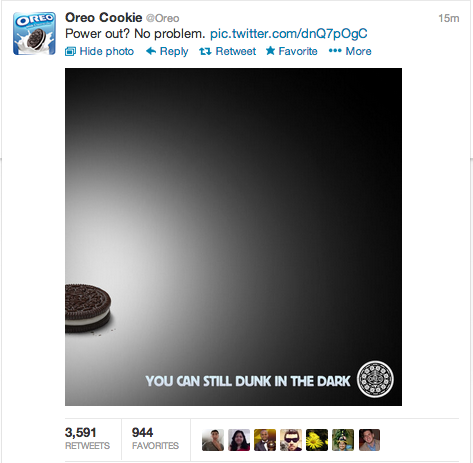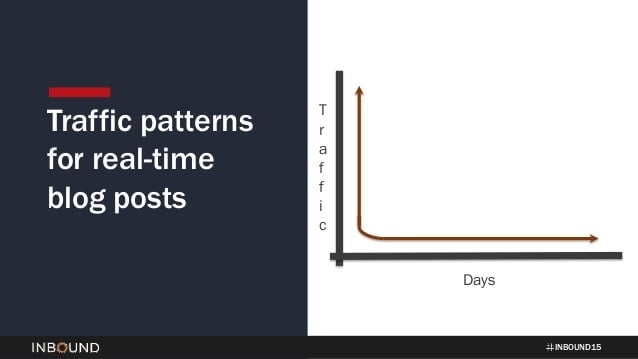Experimenting with real-time marketing? Before you commit a ton of time and energy to your latest campaign, learn how to avoid the 5 major pitfalls of real-time marketing.
What is Real-Time Marketing?
During 2013's famous Super Bowl blackout, fans, organisers and players alike were left groping about in the eerie twilight of the New Orleans Superdome. Determined to find out what had happened, thousands took to social media. There, they were greeted by Oreo:

This is an example of real-time marketing: a company responding to a real-world event in a timely and relevant manner. When the blackout happened, Oreo were quick off the mark, creating a unique and relevant graphic within minutes of the power going out. Their tweet garnered over 15,000 shares in 14 hours.
However, for every real-time success, there are thousands of near-misses, misses and disasters. Before you dive headlong into the fray of real-time marketing, there a couple of caveats you need to consider:
1) You Need a Big Budget to Do It Right
Real-time marketing relies on speed. You need to be able to identify opportunities, the second they appear, and create high-quality content to capitalise on them. For that to happen, you'll need:
- Listening mechanisms. You need people and tools to identify opportunities - mentions of your brand, commentary about your industry, or big events that are relevant to your business.
- Alerting mechanisms. Once an opportunity is identified, the right people need to be alerted, from junior designers to senior directors.
- Autonomy. The clock is ticking, so your team need the autonomy to get started immediately.
- Capability. You need concepts, copy, featured images and infographics... and you need it now.
2) It’s Unpredictable
For all the effort that goes into it, real-time marketing is seriously hit or miss. Anything that relies on virality elicits a binary response: and for every runaway success you create, you'll create a dozen flops.
Even when real-time marketing succeeds, its benefits tend to be pretty short-lived. Once the initial surge of popularity dies down, and the event that triggered it is just a memory, your content fades away into obscurity.
As HubSpot's Corey Eridon explains, this results in a traffic graph that looks like this:

3) It Can Backfire
Trying to shoe-horn your brand into cultural events doesn't always end well.
In response to the tragedy of the Boston bombings, Epicurious offered a grieving nation a 'bowl of breakfast energy' to help them through...

...and in the wake of the uprisings of the Arab Spring, Kenneth Cole saw an opportunity to respond with an empathetic plug of their latest clothing line.

Real-time marketing should be about responding to opportunities, not bludgeoning opportunities into existence.
Instead of imposing your brand onto an event for the sake of publicity and exposure, you need to wait for opportunities to add value - and if you find yourself desperately groping for relevance, you should probably hit delete on that tweet.
4) It Doesn't Always Add Value
This post was inspired by a great presentation I saw at Inbound 2015.
Whilst I sat, listened and learned, dozens around me scribbled notes directly into LinkedIn, and live-Tweeted quotes. When I came to search for a Slideshare of the talk, I had to wade through dozens of half-written round-ups, consisting of hastily scrawled phrases that meant little to me, and even less to people who weren't in attendance.
Before you let loose your latest real-time post, ask yourself a simple question: why am I writing about this?
If you're trying to highlight the fact that you were at an industry event, by all means, hit publish on that disjointed collection of unintelligible notes.
But if you're trying to add value to your reader, it makes sense to wait, and collect as many opinions, statistics and supporting materials as possible. Instead of publishing a half-written mess of fleetingly relevant content, you can publish something that continues to add value to your reader, weeks and months down the line.
You can create evergreen content.
5) Evergreen Content is Better
When I talk about evergreen content, I'm referring to timeless content that forms the base of an inbound marketing strategy, not timely content. I'm referring to blog posts, guides, infographics and images that don't have an expiration date, and continue to be helpful and relevant long after they were published.
Real-time content can generate huge surges in traffic, but those surges are almost always short-lived. Worse still, they don't translate into metrics that matter, like leads, and customers.
Case in point, when HubSpot analysed the efficacy of their blog content, they found that real-time marketing had little influence over visits or leads:
- 76% of HubSpot's monthly blog views come from "old" posts (those published prior to that month).
- 92% of HubSpot's blog leads come from "old" posts.
In other words, it isn't the topical, real-time content that generates the most benefit for your business - it's the detailed, well-researched evergreen pieces.
So how can you create evergreen content? Easy. Write about things that your audience will always care about.
When sporting fixtures and holidays have faded from your reader's mind, their problems and passions will still be important. Then, when you have a stable of evergreen content to fall back on, you can use real-time marketing to boost your growth.
Just don't rely on it.




